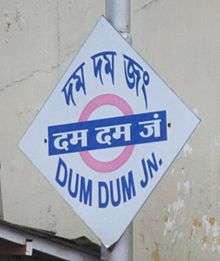Dum Dum Junction railway station
Dum Dum Junction | |||||||||||||||||||||
|---|---|---|---|---|---|---|---|---|---|---|---|---|---|---|---|---|---|---|---|---|---|
| Kolkata Suburban Railway Junction Station | |||||||||||||||||||||
 | |||||||||||||||||||||
| Location |
Dum Dum road, Dum Dum, Distt:North 24 Parganas, West Bengal India | ||||||||||||||||||||
| Coordinates | 22°37′15″N 88°23′36″E / 22.6209°N 88.3933°ECoordinates: 22°37′15″N 88°23′36″E / 22.6209°N 88.3933°E | ||||||||||||||||||||
| Elevation | 10.00 metres (32.81 ft) | ||||||||||||||||||||
| Owned by | Indian Railways | ||||||||||||||||||||
| Operated by | Eastern Railway | ||||||||||||||||||||
| Line(s) |
Sealdah-Barrackpore-Naihati-Ranaghat-Krishnanagar City main line | ||||||||||||||||||||
| Platforms | 5 | ||||||||||||||||||||
| Tracks | 7 | ||||||||||||||||||||
| Construction | |||||||||||||||||||||
| Structure type | Standard (on ground station) | ||||||||||||||||||||
| Parking | No | ||||||||||||||||||||
| Bicycle facilities | No | ||||||||||||||||||||
| Other information | |||||||||||||||||||||
| Status | Functioning | ||||||||||||||||||||
| Station code | DDJ | ||||||||||||||||||||
| Division(s) | Sealdah | ||||||||||||||||||||
| History | |||||||||||||||||||||
| Opened | 1862 | ||||||||||||||||||||
| Electrified | 1963-65 | ||||||||||||||||||||
| Previous names | East Indian Railway | ||||||||||||||||||||
| Services | |||||||||||||||||||||
| |||||||||||||||||||||
| Location | |||||||||||||||||||||
 Dum Dum railway station Location in West Bengal | |||||||||||||||||||||
Dum Dum is a Kolkata Suburban Railway Junction Station on the Sealdah-Ranaghat line. Two lines branch out after Dum Dum – the Calcutta chord line to Dankuni and the Sealdah-Hasnabad-Bangaon-Ranaghat line to Bangaon and Hasnabad. The Dum Dum metro station is adjacent to Dum Dum railway station. It is located in North 24 Parganas district in the Indian state of West Bengal. It serves Dum Dum and the surrounding areas.
History
The Calcutta (Sealdah)-Kusthia line of Eastern Bengal Railway was opened to traffic in 1862.[1] Eastern Bengal Railway worked on the eastern side of the Hooghly River, which in those days was unbridged.[2]
In 1882–84 the Bengal Central Railway Company constructed two lines: one from Dum Dum to Khulna, now in Bangladesh, via Bangaon and the other linking Ranaghat and Bangaon.[3] The Bengal Central Railway was formed in 1881 to construct and operate a line to Khulna. It was merged with Eastern Bengal Railway in 1903.[4]
The 33.06 km (21 mi) long 1,676 mm (5 ft 6 in) wide broad gauge line from Barasat to Hasnabad was constructed between 1957 and 1962.[5]
In 1932, the Calcutta chord line was built over the Willingdon Bridge joining Dum Dum and Dankuni.[3]
Electrification
The Sealdah-Ranaghat sector and the Dum Dum-Barasat-Ashok Nagar-Bangaon sector were electrified in 1963–64. The Dum Dum-Dankuni sector was electrified in 1964-65.[6]
Passengers

Dum Dum railway station handles 576,000 passengers daily.[7]
References
- ↑ "IR History: Early days (1832–1865)". IRFCA. Retrieved 2 May 2013.
- ↑ "Eastern Begal Railway". fibis. Retrieved 2 May 2013.
- 1 2 "The Chronology of Railway development in Eastern Indian". railindia. Retrieved 2 May 2013.
- ↑ "Bengal Central Railway". fibis. Retrieved 2 May 2013.
- ↑ Moonis Raza & Yash Aggarwal. "Transport Geography of India: Commodity Flow and the Regional Structure of Indian Economy". page 60. Concept Publishing Company, A-15/16 Commercial Block, Mohan Garden, New Delhi - 110059. ISBN 81-7022-089-0. Retrieved 2 May 2013.
- ↑ "History of Electrification". IRFCA. Retrieved 5 May 2013.
- ↑ "Dum Dum". Railenquiry.in. Retrieved 18 May 2014.
External links
- Long distance trains at Dum Dum
- Sealdah-Dum Dum trains
- Dum Dum-Sealdah trains
- Dum Dum-Lalgola trains
- Dum Dum-Bangaon trains
- Dum Dum-Dankuni trains
-
 Kolkata/Northern fringes travel guide from Wikivoyage
Kolkata/Northern fringes travel guide from Wikivoyage